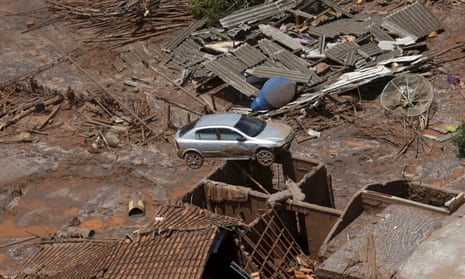As despair turns to anger over a deadly dam burst at a Brazilian mine, lawmakers pushed on Tuesday for tougher regulations in a new mining code, as iron ore giant Vale SA came under pressure to help mourning families and contain the environmental impact.
In five days of rescue efforts in towns ravaged by the massive mudflow, six bodies have been found and 22 people are still missing, making it one of the worst mining disasters in Brazil’s history. Rescuers abandoned a search for seven-year-old Tiago Damasceno in the muddy aftermath of the dam collapse on Tuesday, as hope for survivors diminishes five days after the disaster.
The tragedy in the mineral-rich south-eastern state of Minas Gerais has displaced hundreds of residents, triggered investigations by prosecutors and spurred calls for stricter oversight of the mining industry, a huge provider of jobs and government tax receipts. No cause has been identified for the dams’ failure, which left about 750 people homeless.
The chief sponsor of a new mining code in congress, Leonardo Quintão, told Reuters on Tuesday that he planned to add measures to tighten regulation of tailings dams like the two that collapsed on Thursday.
Minas Gerais’ governor, Fernando Pimentel, acknowledged state mining regulations are not enough and his aides said they may need to rethink their efforts to fast-track licensing.
Public criticism fell first on mine operator Samarco, but the spotlight has turned to the big names behind the 50-50 joint venture: Australia-based BHP Billiton Ltd, the world’s largest mining company, and Brazilian partner Vale, the biggest iron ore miner.
“Samarco is just a name they made up. We need BHP and Vale to take responsibility for this tragedy,” said Duarte Junior, mayor of the town of Mariana, who has coordinated relief efforts.
BHP’s public response has been rapid, but Vale, which accounted for more than 10% of Brazil’s total exports in 2013, has so far appeared aloof.
BHP chief executive Andrew Mackenzie held a news conference in the hours following the disaster and the company announced he would travel to Brazil to survey the damage. It has also splashed almost daily updates on the tragedy in English and Portuguese across the top of its website.
By contrast, Vale released a five-sentence statement some 24 hours after the dams collapsed and referred questions to Samarco. Vale’s chief executive, Murilo Ferreira, made an unannounced visit to Mariana on Saturday, which the company revealed two days later.
Mariana’s mayor has worked closely with Samarco, but he said on Monday that no senior executives from Vale or BHP Billiton had contacted him.
Influential columnist Miriam Leitão excoriated the company on Tuesday for its “absolutely insufficient” response.
“Vale has been drilling and dumping around Minas Gerais for 70 years,” Leitão wrote in the newspaper O Globo. “After a disaster of this scale, it can’t issue a laconic statement as if it weren’t obliged to act immediately.”
She called on Ferreira to explain how Vale will compensate displaced families, contain the environmental damage and monitor the ongoing effects of the spill downstream.
Asked for a response, Vale representatives reiterated that Ferreira had met with Samarco executives and offered helicopters and other equipment for the rescue efforts.
Leitão also pilloried the federal government for leaving state authorities to sort out the environmental impact of the collapsed dams and 60m cubic meters of wastewater contaminating rivers and coastline more than 300 miles (500km) away.
Biologists warn that the environmental impact may be permanent, devastating local fisheries and farms.
The destruction reached as far as about 60 miles (100km) from the burst dams, with dozens of houses now little more than bare walls. Firefighters have managed to open one street in the worst-affected village of Bento Rodrigues, but for many there is no home to go back to.
Tourism and other industries are already suffering. Wood pulp maker Cenibra suspended operations at two production lines due to the mudflow threatening its water source.
President Dilma Rousseff has not traveled to the disaster area, although she said in at a speech on Tuesday that she is “very worried” about the mud and waste from the burst dams making its way downstream. She said her government was ready to help state and local authorities.

Comments (…)
Sign in or create your Guardian account to join the discussion